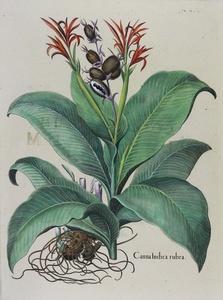| Method | Copper engraving with hand colouring |
| Artist | Basilius Besler |
| Published | [1613-1713] |
| Dimensions | Image 460 x 385 mm, Sheet 540 x 420 mm |
| Notes |
Plate 332 from the 'Autumn' part of Besler's landmark 'Hortus Eystettensis'. The plate shows a Red Canna. Basilius Besler (1561 – 1629) was a respected Nuremberg apothecary and botanist, best known for his monumental 'Hortus Eystettensis'. He was curator of the garden of Johann Konrad von Gemmingen, prince bishop of Eichstätt in Bavaria. The bishop commissioned Besler to compile a codex of the plants growing in his garden, a task which Besler took sixteen years to complete, Johann Konrad dying shortly before the work was published. Where as previous botanical art had placed an emphasis only on medical or culinary herbs, often crudely executed, Besler's 'Hortus Eystettensis' depicted 1084 species including garden flowers, herbs and vegetables and exotic plants such as castor-oil and arum lilies. These were modern in concept and produced near life size in great detail. The work generally reflected the four seasons, showing first the flowering and then the fruiting stages. "Winter" was sparsely represented with a mere 7 plates. "Spring" was a season of abundance with 134 plates illustrating 454 plants and "Summer" in full swing showed 505 plants on 184 plates. "Autumn" closed off the work with 42 plates and 98 species. First published in 1613, two versions were produced, cheap black and white for use as a reference book, and a luxury version without text, printed on quality paper and lavishly hand-coloured. The work was published twice more in Nuremberg in 1640 and 1713. The plates were eventually destroyed by the Royal Mint of Munich in 1817. Condition: Some printers creases across the sheet. |
| Framing | framed |
| Price | £2,000.00 |
| Stock ID | 48002 |

